Thermal Conductivity of Graphene-Polymer Composites: Mechanisms, Properties, and Applications
Abstract
:1. Introduction
2. Thermal Conductive Mechanisms
2.1. Thermal Conductive Mechanisms in Graphene
2.2. Thermal Conductive Mechanisms in Polymers
2.3. Thermal Conductive Mechanisms in Graphene-Polymer Composites
3. Recent Advances in Thermal Conductivity of Graphene-Polymer Composites
3.1. Graphene with Random Orientation in the Polymer Matrix
3.2. Graphene with Specific Orientation in the Polymer Matrix
4. Influence Factors on Thermal Conductivity of Graphene-Polymer Composites
4.1. The Characteristics of Graphene
4.2. The Loading of Graphene
4.3. The Orientation of Graphene in the Polymer Matrix
4.4. The Interface between Graphene and the Polymer
5. Applications of Graphene-Polymer Composites in Thermal Engineering
5.1. Electronic Packaging
5.2. Thermal Energy Storage
5.3. Batteries
6. Conclusions
Acknowledgments
Author Contributions
Conflicts of Interest
Abbreviations
| Py-PGMA-GNS/epoxy | Pyrene-end poly(glycidyl methacrylate)-graphene nanosheet/epoxy composite |
| f-GFs/epoxy | Non-covalently functionalized graphene flakes/epoxy composite |
| GnP-C750/epoxy | Graphene nanoplatelets (sizes < 1 μm)/epoxy composite |
| DGEBA-f-GO/epoxy | Diglycidyl ether of bisphenol-A functionalized graphene oxide/epoxy composite |
| GS@Al2O3/PVDF | Alumina-coated graphene sheet/poly(vinylidene fluoride) composite |
| Al2O3@GNP/epoxy | Alumina nanoparticles decorated graphene nanoplatelets/epoxy composite |
| GNP/PBT | Graphene nanoplatelet/polybutylene terephthalate composite |
| GNPs/PPS | Graphene nanoplatelets/polyphenylene sulfide composite |
| PI/SiCNWs-GSs | Polyimide/SiC nanowires grown on graphene sheets composite |
| GP/SR | Graphene/silicone rubber |
| PA6/graphene-GO | Polyamide-6/graphene-graphene oxide composite |
| GNP/epoxy | Graphene nanoplatelets/epoxy composite |
| PVDF/FGS/ND | Poly(vinylidene fluoride)/functionalized graphene sheets/nanodiamonds composite |
| ApPOSS-graphene/epoxy | Aminopropylisobutyl polyhedral oligomeric silsesquioxane grafted graphene/epoxy composite |
| IL-G/PU | 1-allyl-methylimidazolium chloride ionic liquid modified graphene/polyurethane composite |
| PA/TCA-rGO | Titanate coupling agent modified reduced graphene/polyamide composite |
| BE/graphene | Bio-based polyester/graphene composite |
| GNPs/silicone | Graphene nanoplatelets/silicone composite |
| VAGF/PDMS | Vertically aligned graphene film/polydimethylsiloxane |
| MLG/epoxy | Multilayer graphene/epoxy composite |
| NFC/RGO | Nanofibrillated cellulose/epoxy composite |
| rLGO/PVDF | Highly self-aligned large-area reduced graphene oxide/poly (vinylidene fluoride-co-hexafluoropropylene) composite |
| PVDF/oGNF | Oriented graphene nanoflake/poly(vinylidene fluoride) (PVDF) composite |
| epoxy/GNS–Fe3O4 | Epoxy/graphene nanosheets-Fe3O4 |
| GNP/PE | Graphene nanoplatelets/polyethylene |
| GNP/PP | Graphene nanoplatelets/polypropylene |
| GNP/PVA | Graphene nanoplatelets/poly(vinyl alcohol) |
| GNP/PVDF | Graphene nanoplatelets/poly(vinylideneuoride) |
| GNP/PS | Graphene nanoplates/polystyrene; RGO/TPU |
| RGO/TPU | Reduced graphene oxide/thermoplastic polyurethane |
| PA6/graphene foam | Polyamide-6/graphene foam |
| GF/epoxy | Graphene foams/epoxy |
| GF/PDMS | Graphene foam/polydimethylsiloxane |
| PEG/HGA | Polyethylene glycol/hybrid graphene aerogels |
References
- Moore, A.L.; Shi, L. Emerging challenges and materials for thermal management of electronics. Mater. Today 2014, 17, 163–174. [Google Scholar] [CrossRef]
- Chen, H.; Ginzburg, V.V.; Yang, J.; Yang, Y.; Liu, W.; Huang, Y.; Du, L.; Chen, B. Thermal Conductivity of Polymer-Based Composites: Fundamentals and Applications. Prog. Polym. Sci. 2016, 59, 41–85. [Google Scholar] [CrossRef]
- Huang, X.; Jiang, P.; Tanaka, T. A review of dielectric polymer composites with high thermal conductivity. IEEE Electr. Insul. Mag. 2011, 27, 8–16. [Google Scholar] [CrossRef]
- Han, Z.; Fina, A. Thermal conductivity of carbon nanotubes and their polymer nanocomposites: A review. Prog. Polym. Sci. 2011, 36, 914–944. [Google Scholar] [CrossRef]
- Agari, Y.; Ueda, A.; Omura, Y.; Nagai, S. Thermal diffusivity and conductivity of PMMA/PC blends. Polymer 1997, 38, 801–807. [Google Scholar] [CrossRef]
- Hu, J.; Huang, Y.; Yao, Y.; Pan, G.; Sun, J.; Zeng, X.; Sun, R.; Xu, J.B.; Song, B.; Wong, C.P. A Polymer Composite with Improved Thermal Conductivity by Constructing Hierarchically Ordered Three-Dimensional Interconnected Network of BN. ACS Appl. Mater. Interfaces 2017, 13544–13553. [Google Scholar] [CrossRef] [PubMed]
- Lim, H.S.; Jin, W.O.; Kim, S.Y.; Yoo, M.J.; Park, S.D.; Lee, W.S. Anisotropically Alignable Magnetic Boron Nitride Platelets Decorated with Iron Oxide Nanoparticles. Chem. Mater. 2013, 25, 3315–3319. [Google Scholar] [CrossRef]
- Yao, Y.; Zeng, X.; Wang, F.; Sun, R.; Xu, J.; Wong, C.P. Significant Enhancement of Thermal Conductivity in Bioinspired Freestanding Boron Nitride Papers Filled with Graphene Oxide. Chem. Mater. 2016, 80, 1357–1359. [Google Scholar] [CrossRef]
- Fang, H.; Bai, S.L.; Wong, C.P. Thermal, mechanical and dielectric properties of flexible BN foam and BN nanosheets reinforced polymer composites for electronic packaging application. Compos. A Appl. Sci. Manuf. 2017, 100, 71–80. [Google Scholar] [CrossRef]
- Yu, A.; Ramesh, P.; Sun, X.; Bekyarova, E.; Itkis, M.E.; Haddon, R.C. Enhanced Thermal Conductivity in a Hybrid Graphite Nanoplatelet—Carbon Nanotube Filler for Epoxy Composites. Adv. Mater. 2010, 20, 4740–4744. [Google Scholar] [CrossRef]
- Moisala, A.; Li, Q.; Kinloch, I.A.; Windle, A.H. Thermal and electrical conductivity of single- and multi-walled carbon nanotube-epoxy composites. Compos. Sci. Technol. 2006, 66, 1285–1288. [Google Scholar] [CrossRef]
- Yang, S.Y.; Ma, C.C.M.; Teng, C.C.; Huang, Y.W.; Liao, S.H.; Huang, Y.L.; Tien, H.W.; Lee, T.M.; Chiou, K.C. Effect of functionalized carbon nanotubes on the thermal conductivity of epoxy composites. Carbon 2010, 48, 592–603. [Google Scholar] [CrossRef]
- Song, Y.S.; Youn, J.R. Evaluation of effective thermal conductivity for carbon nanotube/polymer composites using control volume finite element method. Carbon 2006, 44, 710–717. [Google Scholar] [CrossRef]
- Nan, C.W.; Liu, G.; Lin, Y.; Li, M. Interface effect on thermal conductivity of carbon nanotube composites. Appl. Phys. Lett. 2004, 85, 3549–3551. [Google Scholar] [CrossRef]
- Choi, S.; Kim, J. Thermal conductivity of epoxy composites with a binary-particle system of aluminum oxide and aluminum nitride fillers. Compos. B Eng. 2013, 51, 140–147. [Google Scholar] [CrossRef]
- Li, B.; Li, R.; Xie, Y. Properties and effect of preparation method of thermally conductive polypropylene/aluminum oxide composite. J. Mater. Sci. 2017, 52, 2524–2533. [Google Scholar] [CrossRef]
- Im, H.; Kim, J. Enhancement of the thermal conductivity of aluminum oxide–epoxy terminated poly(dimethyl siloxane) with a metal oxide containing polysiloxane. J. Mater. Sci. 2011, 46, 6571–6580. [Google Scholar] [CrossRef]
- Kidalov, S.V.; Shakhov, F.M. Thermal Conductivity of Diamond Composites. Materials 2009, 2, 2467–2495. [Google Scholar] [CrossRef]
- Cho, H.B.; Konno, A.; Fujihara, T.; Suzuki, T.; Tanaka, S.; Jiang, W.; Suematsu, H.; Niihara, K.; Nakayama, T. Self-assemblies of linearly aligned diamond fillers in polysiloxane/diamond composite films with enhanced thermal conductivity. Compos. Sci. Technol. 2012, 72, 112–118. [Google Scholar] [CrossRef]
- Yu, J.; Qian, R.; Jiang, P. Enhanced thermal conductivity for PVDF composites with a hybrid functionalized graphene sheet-nanodiamond filler. Fibers Polym. 2013, 14, 1317–1323. [Google Scholar] [CrossRef]
- Saw, W.P.S.; Mariatti, M. Properties of synthetic diamond and graphene nanoplatelet-filled epoxy thin film composites for electronic applications. J. Mater. Sci. Mater. Electron. 2012, 23, 817–824. [Google Scholar] [CrossRef]
- Shtein, M.; Nadiv, R.; Buzaglo, M.; Kahil, K.; Regev, O. Thermally Conductive Graphene-Polymer Composites: Size, Percolation, and Synergy Effects. Chem. Mater. 2015, 27, 2100–2106. [Google Scholar] [CrossRef]
- Yavari, F.; Fard, H.R.; Pashayi, K.; Rafiee, M.A.; Zamiri, A.; Yu, Z.; Ozisik, R.; Borcatasciuc, T.; Koratkar, N. Enhanced Thermal Conductivity in a Nanostructured Phase Change Composite due to Low Concentration Graphene Additives. J. Phys. Chem. C 2011, 115, 8753–8758. [Google Scholar] [CrossRef]
- Geim, A.K. Graphene: status and prospects. Science 2009, 324, 1530–1534. [Google Scholar] [CrossRef] [PubMed]
- Balandin, A.A.; Ghosh, S.; Bao, W.; Calizo, I.; Teweldebrhan, D.; Miao, F.; Lau, C.N. Superior thermal conductivity of single-layer graphene. Nano Lett. 2008, 8, 902–907. [Google Scholar] [CrossRef] [PubMed]
- Maldovan, M. Sound and heat revolutions in phononics. Nature 2013, 503, 209–217. [Google Scholar] [CrossRef] [PubMed]
- Balandin, A.A. Thermal properties of graphene and nanostructured carbon materials. Nat. Mater. 2011, 10, 569. [Google Scholar] [CrossRef] [PubMed]
- Pu, H.H.; Rhim, S.H.; Hirschmugl, C.J.; Gajdardziska-Josifovska, M.; Weinert, M.; Chen, J.H. Anisotropic thermal conductivity of semiconducting graphene monoxide. Appl. Phys. Lett. 2013, 102, 569–581. [Google Scholar] [CrossRef]
- Burger, N.; Laachachi, A.; Ferriol, M.; Lutz, M.; Toniazzo, V.; Ruch, D. Review of thermal conductivity in composites: Mechanisms, parameters and theory. Prog. Polym. Sci. 2016, 61, 1–28. [Google Scholar] [CrossRef]
- Narula, R.; Bonini, N.; Marzari, N.; Reich, S. Dominant phonon wave vectors and strain-induced splitting of the 2D Raman mode of graphene. Phys. Rev. B 2012, 85, 115451. [Google Scholar] [CrossRef]
- Yao, W.; Cao, B. Triggering wave-domain heat conduction in graphene. Phys. Lett. A 2016, 380, 2105–2110. [Google Scholar] [CrossRef]
- Yao, W.; Cao, B. Thermal wave propagation in graphene studied by molecular dynamics simulations. Chin. Sci. Bull. 2014, 59, 3495–3503. [Google Scholar] [CrossRef]
- Ghosh, S.; Calizo, I.; Teweldebrhan, D.; Pokatilov, E.P. Extremely high thermal conductivity of graphene: Prospects for thermal management applications in nanoelectronic circuits. Appl. Phys. Lett. 2008, 92, 151911–151913. [Google Scholar] [CrossRef]
- Zhixin, G.; Dier, Z.; Xingao, G. Thermal conductivity of graphene nanoribbons. Appl. Phys. Lett. 2009, 95, 163103. [Google Scholar] [CrossRef]
- Nika, D.L.; Ghosh, S.; Pokatilov, E.P.; Balandin, A.A. Lattice thermal conductivity of graphene flakes: Comparison with bulk graphite. Appl. Phys. Lett. 2009, 94, 203103. [Google Scholar] [CrossRef]
- Faugeras, C.; Faugeras, B.; Orlita, M.; Potemski, M.; Nair, R.R.; Geim, A.K. Thermal conductivity of graphene in corbino membrane geometry. ACS Nano 2010, 4, 1889–1892. [Google Scholar] [CrossRef] [PubMed]
- Rossinsky, E.; Müllerplathe, F. Anisotropy of the thermal conductivity in a crystalline polymer: Reverse nonequilibrium molecular dynamics simulation of the delta phase of syndiotactic polystyrene. J. Chem. Phys. 2009, 130, 134905. [Google Scholar] [CrossRef] [PubMed]
- Choy, C.L.; Greig, D. The low-temperature thermal conductivity of a semi-crystalline polymer, polyethylene terephthalate. J. Phys. C Solid State Phys. 1975, 8, 3121–3130. [Google Scholar] [CrossRef]
- Choy, C.L.; Chen, F.C.; Luk, W.H. Thermal conductivity of oriented crystalline polymers. J. Polym. Sci. Polym. Phys. 1980, 18, 1187–1207. [Google Scholar] [CrossRef]
- Lee, J.H.; Koh, C.Y.; Singer, J.P.; Jeon, S.J.; Maldovan, M.; Stein, O.; Thomas, E.L. 25th anniversary article: ordered polymer structures for the engineering of photons and phonons. Adv. Mater. 2014, 26, 532–569. [Google Scholar] [CrossRef] [PubMed]
- Xu, P.; Loomis, J.; Bradshaw, R.D.; Panchapakesan, B. Load transfer and mechanical properties of chemically reduced graphene reinforcements in polymer composites. Nanotechnology 2012, 23, 3847–3856. [Google Scholar] [CrossRef] [PubMed]
- Luo, T.; Lloyd, J.R. Enhancement of Thermal Energy Transport Across Graphene/Graphite and Polymer Interfaces: A Molecular Dynamics Study. Adv. Funct. Mater. 2012, 22, 2495–2502. [Google Scholar] [CrossRef]
- Liu, Y.; Huang, J.; Yang, B.; Sumpter, B.G.; Qiao, R. Duality of the interfacial thermal conductance in graphene-based nanocomposites. Carbon 2014, 75, 169–177. [Google Scholar] [CrossRef]
- Kuila, T.; Bose, S.; Hong, C.E.; Uddin, M.E.; Khanra, P.; Kim, N.H.; Lee, J.H. Preparation of functionalized graphene/linear low density polyethylene composites by a solution mixing method. Carbon 2011, 49, 1033–1037. [Google Scholar] [CrossRef]
- Garzón, C.; Palza, H. Electrical behavior of polypropylene composites melt mixed with carbon-based particles: Effect of the kind of particle and annealing process. Compos. Sci. Technol. 2014, 99, 117–123. [Google Scholar] [CrossRef]
- Hu, Z.; Li, N.; Li, J.; Zhang, C.; Song, Y.; Li, X.; Wu, G.; Xie, F.; Huang, Y. Facile preparation of poly(p-phenylene benzobisoxazole)/graphene composite films via one-pot in situ polymerization. Polymer 2015, 71, 8–14. [Google Scholar] [CrossRef]
- Yu, A.; Ramesh, P.; Itkis, M.E.; Elena Bekyarova, A.; Haddon, R.C. Graphite Nanoplatelet−Epoxy Composite Thermal Interface Materials. J. Phys. Chem. C 2007, 111, 7565–7569. [Google Scholar] [CrossRef]
- Irwin, P.C.; Cao, P.; Bansal, A.; Schadler, L.S. Thermal and mechanical properties of polyimide nanocomposites. In Proceedings of the 2003 Annual Report Conference on Electrical Insulation and Dielectric Phenomena, Albuquerque, NM, USA, 19–22 October 2003; pp. 120–123. [Google Scholar] [CrossRef]
- Min, C.; Yu, D.; Cao, J.; Wang, G.; Feng, L. A graphite nanoplatelet/epoxy composite with high dielectric constant and high thermal conductivity. Carbon 2013, 55, 116–125. [Google Scholar] [CrossRef]
- Al-Saygh, A.; Ponnamma, D.; Almaadeed, M.; Poornima, V.P.; Karim, A.; Hassan, M. Flexible Pressure Sensor Based on PVDF Nanocomposites Containing Reduced Graphene Oxide-Titania Hybrid Nanolayers. Polymers 2017, 9, 33. [Google Scholar] [CrossRef]
- Li, Y.; Lian, H.; Hu, Y.; Chang, W.; Cui, X.; Liu, Y. Enhancement in Mechanical and Shape Memory Properties for Liquid Crystalline Polyurethane Strengthened by Graphene Oxide. Polymers 2016, 8, 236. [Google Scholar] [CrossRef]
- Kim, D.S.; Dhand, V.; Rhee, K.Y.; Park, S.J. Study on the Effect of Silanization and Improvement in the Tensile Behavior of Graphene-Chitosan-Composite. Polymers 2015, 7, 527–551. [Google Scholar] [CrossRef]
- Kim, H.; Macosko, C.W. Processing-property relationships of polycarbonate/graphene composites. Polymer 2009, 50, 3797–3809. [Google Scholar] [CrossRef]
- Tian, L.; Wang, Y.; Li, Z.; Mei, H.; Shang, Y. The thermal conductivity-dependant drag reduction mechanism of water droplets controlled by graphene/silicone rubber composites. Exp. Therm. Fluid Sci. 2017, 85, 363–369. [Google Scholar] [CrossRef]
- Teng, C.C.; Ma, C.C.M.; Lu, C.H.; Yang, S.Y.; Lee, S.H.; Hsiao, M.C.; Yen, M.Y.; Chiou, K.C.; Lee, T.M. Thermal conductivity and structure of non-covalent functionalized graphene/epoxy composites. Carbon 2011, 49, 5107–5116. [Google Scholar] [CrossRef]
- Song, S.H.; Park, K.H.; Kim, B.H.; Choi, Y.W.; Jun, G.H.; Lee, D.J.; Kong, B.S.; Paik, K.W.; Jeon, S. Enhanced thermal conductivity of epoxy-graphene composites by using non-oxidized graphene flakes with non-covalent functionalization. Adv. Mater. 2013, 25, 732–737. [Google Scholar] [CrossRef] [PubMed]
- Wang, F.; Drzal, L.T.; Yan, Q.; Huang, Z. Mechanical properties and thermal conductivity of graphene nanoplatelet/epoxy composites. J. Mater. Sci. 2015, 50, 1082–1093. [Google Scholar] [CrossRef]
- Wan, Y.; Tang, L.; Gong, L.; Yan, D.; Li, Y.; Wu, L.; Jiang, J.; Lai, G. Grafting of epoxy chains onto graphene oxide for epoxy composites with improved mechanical and thermal properties. Carbon 2014, 69, 467–480. [Google Scholar] [CrossRef]
- Qian, R.; Yu, J.; Wu, C.; Zhai, X.; Jiang, P. Alumina-coated graphene sheet hybrids for electrically insulating polymer composites with high thermal conductivity. RSC Adv. 2013, 3, 17373–17379. [Google Scholar] [CrossRef]
- Sun, R.; Yao, H.; Zhang, H.B.; Li, Y.; Mai, Y.W.; Yu, Z.Z. Decoration of defect-free graphene nanoplatelets with alumina for thermally conductive and electrically insulating epoxy composites. Compos. Sci. Technol. 2016, 137, 16–23. [Google Scholar] [CrossRef]
- Kim, S.Y.; Ye, J.N.; Yu, J. Thermal conductivity of graphene nanoplatelets filled composites fabricated by solvent-free processing for the excellent filler dispersion and a theoretical approach for the composites containing the geometrized fillers. Compos. A Appl. Sci. Manuf. 2015, 69, 219–225. [Google Scholar] [CrossRef]
- Gu, J.; Xie, C.; Li, H.; Dang, J.; Geng, W.; Zhang, Q. Thermal percolation behavior of graphene nanoplatelets/polyphenylene sulfide thermal conductivity composites. Polym. Compos. 2014, 35, 1087–1092. [Google Scholar] [CrossRef]
- Dai, W.; Yu, J.; Liu, Z.; Wang, Y.; Song, Y.; Lyu, J.; Bai, H.; Nishimura, K.; Jiang, N. Enhanced thermal conductivity and retained electrical insulation for polyimide composites with SiC nanowires grown on graphene hybrid fillers. Compos. A Appl. Sci. Manuf. 2015, 76, 73–81. [Google Scholar] [CrossRef]
- Chen, J.; Chen, X.; Meng, F.; Li, D.; Tian, X.; Wang, Z.; Zhou, Z. Super-high thermal conductivity of polyamide-6/graphene-graphene oxide composites through in situ polymerization. High Perform. Polym. 2016, 585–594. [Google Scholar] [CrossRef]
- Guo, W.; Chen, G. Fabrication of graphene/epoxy resin composites with much enhanced thermal conductivity via ball milling technique. J. Appl. Polym. Sci. 2014, 131, 338–347. [Google Scholar] [CrossRef]
- Zong, P.; Fu, J.; Chen, L.; Yin, J.; Dong, X.; Yuan, S.; Shi, L.Y.; Deng, W. Effect of Aminopropylisobutyl Polyhedral Oligomeric Silsesquioxane Functionalized Graphene on the Thermal Conductivity and Electrical Insulation Properties of Epoxy Composites. RSC Adv. 2016, 6, 10498–10506. [Google Scholar] [CrossRef]
- Ma, W.S.; Li, W.; Fang, Y.; Wang, S.F. Non-covalently modified reduced graphene oxide/polyurethane nanocomposites with good mechanical and thermal properties. J. Mater. Sci. 2014, 49, 562–571. [Google Scholar] [CrossRef]
- Cho, E.C.; Huang, J.H.; Li, C.P.; Chang-Jian, C.W.; Lee, K.C.; Hsiao, Y.S.; Huang, J.H. Graphene-based thermoplastic composites and their application for LED thermal management. Carbon 2016, 102, 66–73. [Google Scholar] [CrossRef]
- Tang, Z.; Kang, H.; Shen, Z.; Guo, B.; Zhang, L.; Jia, D. Grafting of Polyester onto Graphene for Electrically and Thermally Conductive Composites. Macromolecules 2012, 45, 3444–3451. [Google Scholar] [CrossRef]
- Varenik, M.; Nadiv, R.; Levy, I.; Vasilyev, G.; Regev, O. Breaking through the Solid/Liquid Processability Barrier: Thermal Conductivity and Rheology in Hybrid Graphene-Graphite Polymer Composites. ACS Appl. Mater. Interfaces 2017, 7556–7564. [Google Scholar] [CrossRef] [PubMed]
- Ling, J.; Zhai, W.; Feng, W.; Shen, B.; Zhang, J.; Zheng, W.G. Facile Preparation of Lightweight Microcellular Polyetherimide/Graphene Composite Foams for Electromagnetic Interference Shielding. ACS Appl. Mater. Interfaces 2013, 5, 2677–2684. [Google Scholar] [CrossRef] [PubMed]
- Li, M.; Gao, C.; Hu, H.; Zhao, Z. Electrical conductivity of thermally reduced graphene oxide/polymer composites with a segregated structure. Carbon 2013, 65, 371–373. [Google Scholar] [CrossRef]
- Hu, H.; Zhang, G.; Xiao, L.; Wang, H.; Zhang, Q.; Zhao, Z. Preparation and electrical conductivity of graphene/ultrahigh molecular weight polyethylene composites with a segregated structure. Carbon 2012, 50, 4596–4599. [Google Scholar] [CrossRef]
- Lin, Y.; Liu, S.; Liu, L. A new approach to construct three dimensional segregated graphene structures in rubber composites for enhanced conductive, mechanical and barrier properties. J. Mater. Chem. C 2016, 4, 2353–2358. [Google Scholar] [CrossRef]
- Wang, M.; Duan, X.; Xu, Y.; Duan, X. Functional Three-Dimensional Graphene/Polymer Composites. ACS Nano 2016, 10, 7231. [Google Scholar] [CrossRef] [PubMed]
- Zhang, Y.F.; Han, D.; Zhao, Y.H.; Bai, S.L. High-performance thermal interface materials consisting of vertically aligned graphene film and polymer. Carbon 2016, 109, 552–557. [Google Scholar] [CrossRef]
- Li, Q.; Guo, Y.; Li, W.; Qiu, S.; Zhu, C.; Wei, X.; Chen, M.; Liu, C.; Liao, S.; Gong, Y. Ultrahigh Thermal Conductivity of Assembled Aligned Multilayer Graphene/Epoxy Composite. Chem. Mater. 2014, 26, 4459–4465. [Google Scholar] [CrossRef]
- Li, X.; Shao, L.; Song, N.; Shi, L.; Ding, P. Enhanced thermal-conductive and anti-dripping properties of polyamide composites by 3D graphene structures at low filler content. Compos. A Appl. Sci. Manuf. 2016, 88, 305–314. [Google Scholar] [CrossRef]
- Yang, J.; Qi, G.Q.; Liu, Y.; Bao, R.Y.; Liu, Z.Y.; Yang, W.; Xie, B.H.; Yang, M.B. Hybrid graphene aerogels/phase change material composites: Thermal conductivity, shape-stabilization and light-to-thermal energy storage. Carbon 2016, 100, 693–702. [Google Scholar] [CrossRef]
- Liu, D.; Yang, P.; Yuan, X.; Guo, J.; Liao, N. The defect location effect on thermal conductivity of graphene nanoribbons based on molecular dynamics. Phys. Lett. A 2015, 379, 810–814. [Google Scholar] [CrossRef]
- Song, N.; Jiao, D.; Cui, S.; Hou, X.; Ding, P.; Shi, L. Highly Anisotropic Thermal Conductivity of Layer-by-Layer Assembled Nanofibrillated Cellulose/Graphene Nanosheets Hybrid Films for Thermal Management. ACS Appl. Mater. Interfaces 2017, 9, 2924. [Google Scholar] [CrossRef] [PubMed]
- Kumar, P.; Yu, S.; Shahzad, F.; Hong, S.M.; Kim, Y.H.; Chong, M.K. Ultrahigh electrically and thermally conductive self-aligned graphene/polymer composites using large-area reduced graphene oxides. Carbon 2016, 101, 120–128. [Google Scholar] [CrossRef]
- Jung, H.; Yu, S.; Bae, N.S.; Cho, S.M.; Kim, R.H.; Cho, S.H.; Hwang, I.; Jeong, B.; Ji, S.R.; Hwang, J.Y. High through-plane thermal conduction of graphene nanoflake filled polymer composites melt-processed in an L-shape kinked tube. ACS Appl. Mater. Interfaces 2015, 7, 15256. [Google Scholar] [CrossRef] [PubMed]
- Yan, H.; Tang, Y.; Long, W.; Li, Y. Enhanced thermal conductivity in polymer composites with aligned graphene nanosheets. J. Mater. Sci. 2014, 49, 5256–5264. [Google Scholar] [CrossRef]
- Alam, F.E.; Dai, W.; Yang, M.; Du, S.; Li, X.; Yu, J.; Jiang, N.; Lin, C.T. In situ formation of a cellular graphene framework in thermoplastic composites leading to superior thermal conductivity. J. Mater. Chem. A 2017, 6164–6169. [Google Scholar] [CrossRef]
- Wu, K.; Lei, C.; Huang, R.; Yang, W.; Chai, S.; Geng, C.; Chen, F.; Fu, Q. Design and Preparation of a Unique Segregated Double Network with Excellent Thermal Conductive Property. ACS Appl. Mater. Interfaces 2017, 9, 7637–7647. [Google Scholar] [CrossRef] [PubMed]
- Li, A.; Zhang, C.; Zhang, Y.F. RGO/TPU composite with a segregated structure as thermal interface material. Compos. A Appl. Sci. Manuf. 2017, 108–114. [Google Scholar] [CrossRef]
- Yang, J.; Li, X.; Han, S.; Zhang, Y.; Min, P.; Koratkar, N.; Yu, Z.Z. Air-dried, high-density graphene hybrid aerogels for phase change composites with exceptional thermal conductivity and shape stability. J. Mater. Chem. A 2016, 18067–18074. [Google Scholar] [CrossRef]
- Liu, Z.; Shen, D.; Yu, J.; Dai, W.; Li, C.; Du, S.; Jiang, N.; Li, H.; Lin, C.T. Exceptionally high thermal and electrical conductivity of three-dimensional graphene-foam-based polymer composites. RSC Adv. 2016, 6, 22364–22369. [Google Scholar] [CrossRef]
- Zhao, Y.H.; Wu, Z.K.; Bai, S.L. Study on thermal properties of graphene foam/graphene sheets filled polymer composites. Compos. A Appl. Sci. Manuf. 2015, 72, 200–206. [Google Scholar] [CrossRef]
- Zabihi, Z.; Araghi, H. Effect of functional groups on thermal conductivity of graphene/paraffin nanocomposite. Phys. Lett. A 2016, 380, 3828–3831. [Google Scholar] [CrossRef]
- Adamyan, V.; Zavalniuk, V. Lattice thermal conductivity of graphene with conventionally isotopic defects. J. Phys. Condens. Matter. 2012, 24, 415401. [Google Scholar] [CrossRef] [PubMed]
- Kim, J.Y.; Lee, J.H.; Grossman, J.C. Thermal transport in functionalized graphene. ACS Nano 2012, 6, 9050–9057. [Google Scholar] [CrossRef] [PubMed]
- Malekpour, H.; Ramnani, P.; Srinivasan, S.; Balasubramanian, G.; Nika, D.L.; Mulchandani, A.; Lake, R.K.; Balandin, A.A. Thermal conductivity of graphene with defects induced by electron beam irradiation. Nanoscale 2016, 8, 14608–14616. [Google Scholar] [CrossRef] [PubMed]
- Xin, G.; Sun, H.; Scott, S.M.; Yao, T.; Lu, F.; Shao, D.; Hu, T.; Wang, G.; Ran, G.; Lian, J. Advanced Phase Change Composite by Thermally Annealed Defect-Free Graphene for Thermal Energy Storage. ACS Appl. Mater. Interfaces 2014, 6, 15262–15271. [Google Scholar] [CrossRef] [PubMed]
- Chu, K.; Li, W.S.; Dong, H. Role of graphene waviness on the thermal conductivity of graphene composites. Appl. Phys. A 2013, 111, 221–225. [Google Scholar] [CrossRef]
- Shen, X.; Wang, Z.; Wu, Y.; Liu, X.; He, Y.B.; Kim, J.K. Multilayer Graphene Enables Higher Efficiency in Improving Thermal Conductivities of Graphene/Epoxy Composites. Nano Lett. 2016, 16, 3585–3593. [Google Scholar] [CrossRef] [PubMed]
- Kim, H.S.; Bae, H.S.; Yu, J.; Kim, S.Y. Thermal conductivity of polymer composites with the geometrical characteristics of graphene nanoplatelets. Sci. Rep. 2016, 6, 26825. [Google Scholar] [CrossRef] [PubMed]
- Zhan, Y.; Lavorgna, M.; Buonocore, G.; Xia, H. Enhancing electrical conductivity of rubber composites by constructing interconnected network of self-assembled graphene with latex mixing. J. Mater. Chem. 2012, 22, 10464–10468. [Google Scholar] [CrossRef]
- Chakraborty, I.; Bodurtha, K.J.; Heeder, N.J.; Godfrin, M.P.; Tripathi, A.; Hurt, R.H.; Shukla, A.; Bose, A. Massive electrical conductivity enhancement of multilayer graphene/polystyrene composites using a nonconductive filler. ACS Appl. Mater. Interfaces 2014, 6, 16472–16475. [Google Scholar] [CrossRef] [PubMed]
- Khan, M.F.S.; Alexander, A.B. Graphene–Multilayer Graphene Nanocomposites as Highly Efficient Thermal Interface Materials. Naon Lett. 2012, 12, 861–867. [Google Scholar] [CrossRef]
- Li, A.; Zhang, C.; Zhang, Y.F. Graphene nanosheets-filled epoxy composites prepared by a fast dispersion method. J. Appl. Polym. Sci. 2017, 134, 45152. [Google Scholar] [CrossRef]
- Gao, Y.; Müllerplathe, F. Increasing the Thermal Conductivity of Graphene-Polyamide-6,6 Nanocomposites by Surface-Grafted Polymer Chains: Calculation with Molecular Dynamics and Effective-Medium Approximation. J. Phys. Chem. B 2016, 120, 1336–1346. [Google Scholar] [CrossRef] [PubMed]
- Wang, Y.; Zhan, H.F.; Xiang, Y.; Yang, C.; Wang, C.M.; Zhang, Y.Y. Effect of Covalent Functionalization on Thermal Transport across Graphene–Polymer Interfaces. J. Phys. Chem. C 2015, 119, 12731–12738. [Google Scholar] [CrossRef] [Green Version]
- Eslami, H.; Mohammadzadeh, L.; Mehdipour, N. Anisotropic heat transport in nanoconfined polyamide-6,6 oligomers: Atomistic reverse nonequilibrium molecular dynamics simulation. J. Chem. Phys. 2012, 136, 104901. [Google Scholar] [CrossRef] [PubMed]
- Eslami, H.; Mohammadzadeh, L.; Mehdipour, N. Reverse nonequilibrium molecular dynamics simulation of thermal conductivity in nanoconfined polyamide-6,6. J. Chem. Phys. 2011, 135, 064703. [Google Scholar] [CrossRef] [PubMed]
- Prasher, R.S.; Matayabas, J.C. Thermal contact resistance of cured gel polymeric thermal interface material. IEEE Trans. Compon. Packag. Technol. 2004, 27, 702–709. [Google Scholar] [CrossRef]
- Liu, J.; Michel, B.; Rencz, M.; Tantolin, C.; Sarno, C.; Miessner, R.; Schuett, K.V.; Tang, X.; Demoustier, S.; Ziaei, A. Recent progress of thermal interface material research—An overview. In Proceedings of the 14th International Workshop on Thermal Inveatigation of ICs and Systems (THERMINIC 2008), Rome, Italy, 24–26 September 2008; pp. 156–162. [Google Scholar] [CrossRef]
- And, M.M.; Winey, K.I. Polymer Nanocomposites Containing Carbon Nanotubes. Macromolecules 2006, 39, 543–545. [Google Scholar] [CrossRef]
- Xu, J.; Munari, A.; Dalton, E.; Mathewson, A. Silver nanowire array-polymer composite as thermal interface material. J. Appl. Phys. 2009, 106, 124310. [Google Scholar] [CrossRef]
- Alkan, C.; Sarı, A.; Karaipekli, A. Preparation, thermal properties and thermal reliability of microencapsulated n-eicosane as novel phase change material for thermal energy storage. Energy Convers. Manag. 2011, 52, 687–692. [Google Scholar] [CrossRef]
- Ji, H.; Sellan, D.P.; Pettes, M.T.; Kong, X.; Ji, J.; Shi, L.; Ruoff, R.S. Enhanced thermal conductivity of phase change materials with ultrathin-graphite foams for thermal energy storage. Energy Environ. Sci. 2014, 7, 1185–1192. [Google Scholar] [CrossRef]
- Mehrali, M.; Latibari, S.T.; Mehrali, M.; Metselaar, H.S.M.; Silakhori, M. Shape-stabilized phase change materials with high thermal conductivity based on paraffin/graphene oxide composite. Energy Convers. Manag. 2013, 67, 275–282. [Google Scholar] [CrossRef]
- Zhong, Y.; Zhou, M.; Huang, F.; Lin, T.; Wan, D. Effect of graphene aerogel on thermal behavior of phase change materials for thermal management. Sol. Energy Mater. Sol. Cells 2013, 113, 195–200. [Google Scholar] [CrossRef]
- Khan, W.S.; Asmatulu, R.; Rodriguez, V.; Ceylan, M. Enhancing thermal and ionic conductivities of electrospun PAN and PMMA nanofibers by graphene nanoflake additions for battery-separator applications. Int. J. Energy Res. 2015, 38, 2044–2051. [Google Scholar] [CrossRef]
- Hallaj, S.A.; Selman, J.R. ChemInform Abstract: A Novel Thermal Management System for Electric Vehicle Batteries Using Phase-Change Material. Cheminform 2001, 32, 3231–3236. [Google Scholar] [CrossRef]
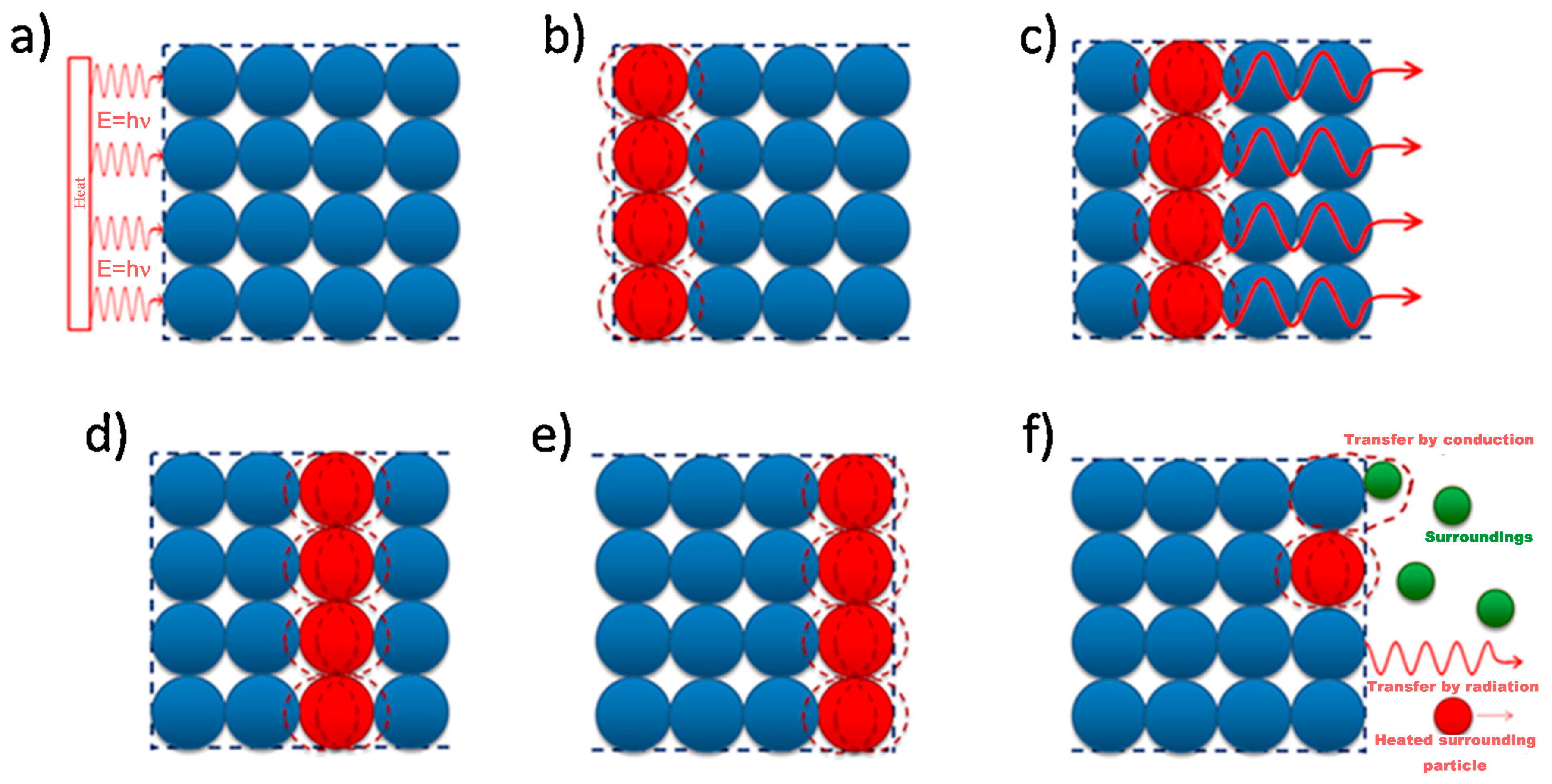
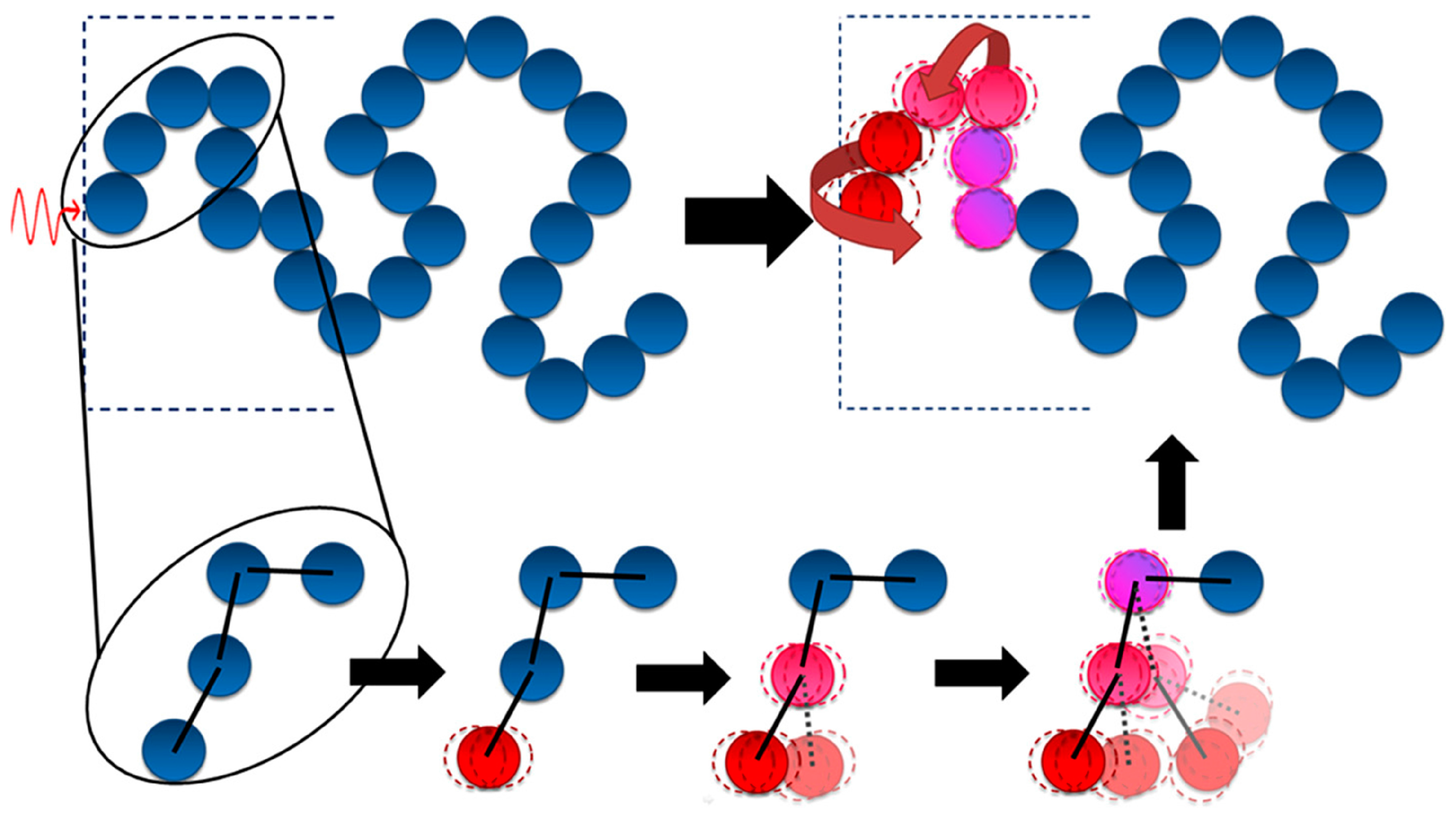
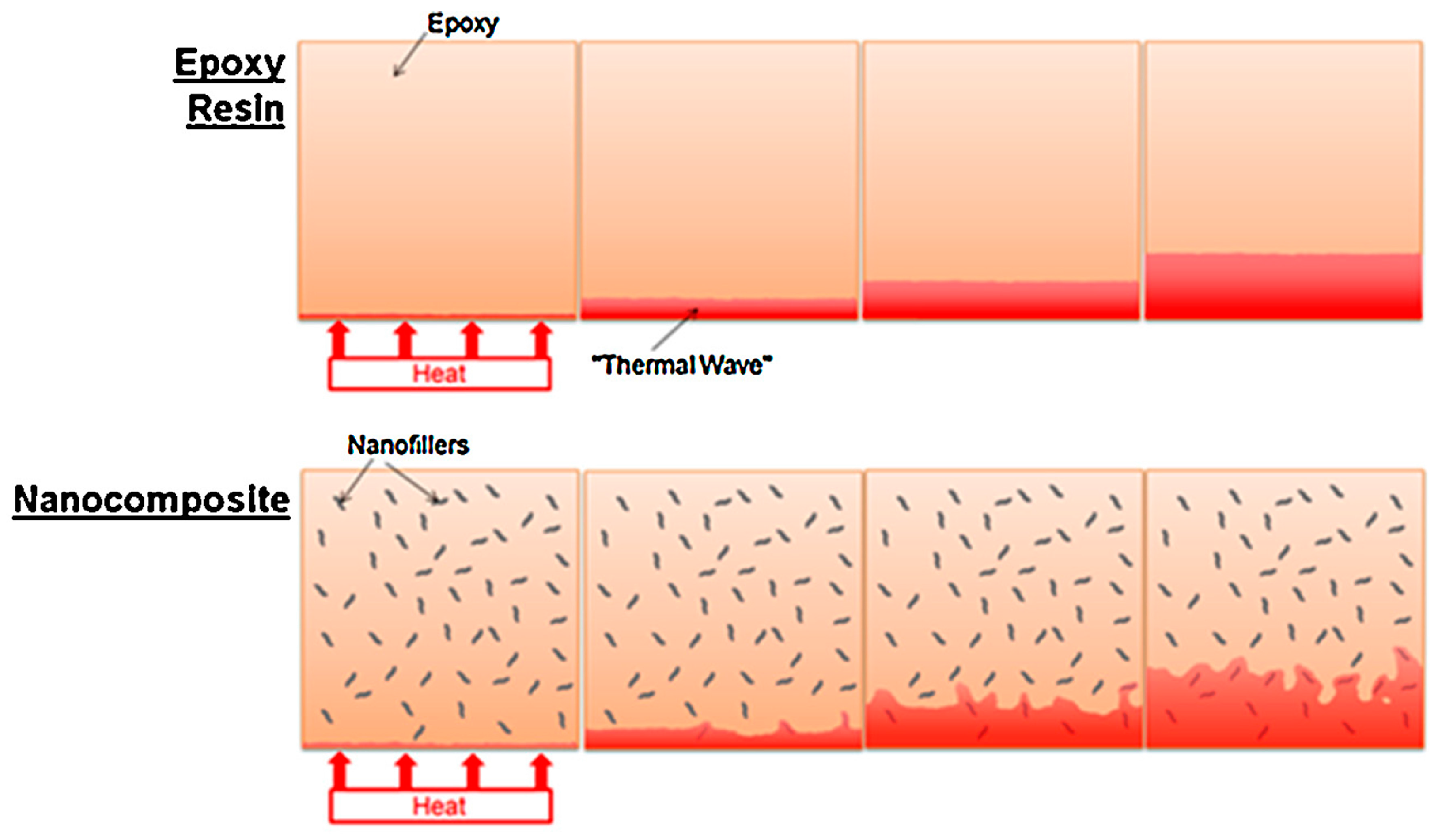
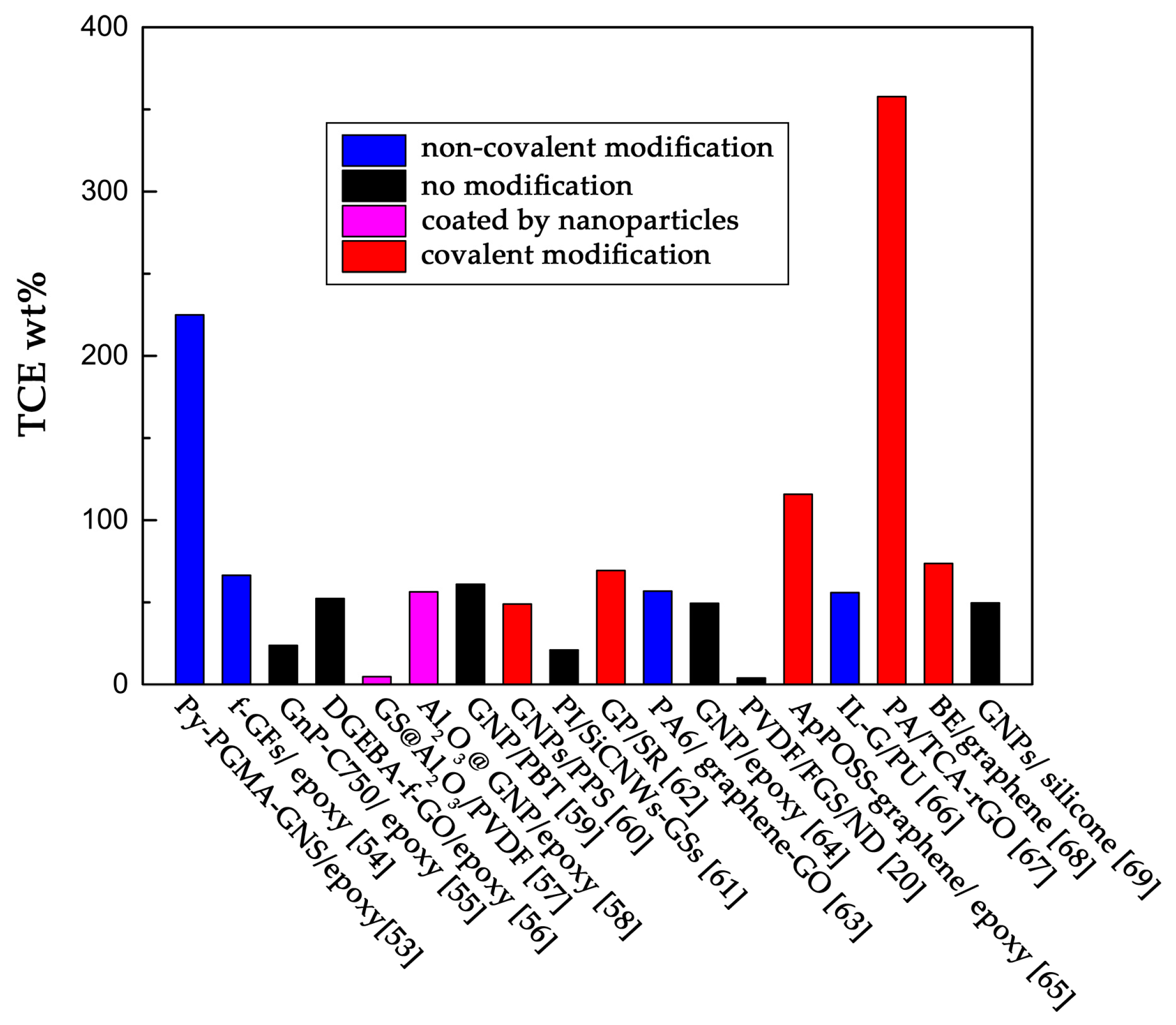
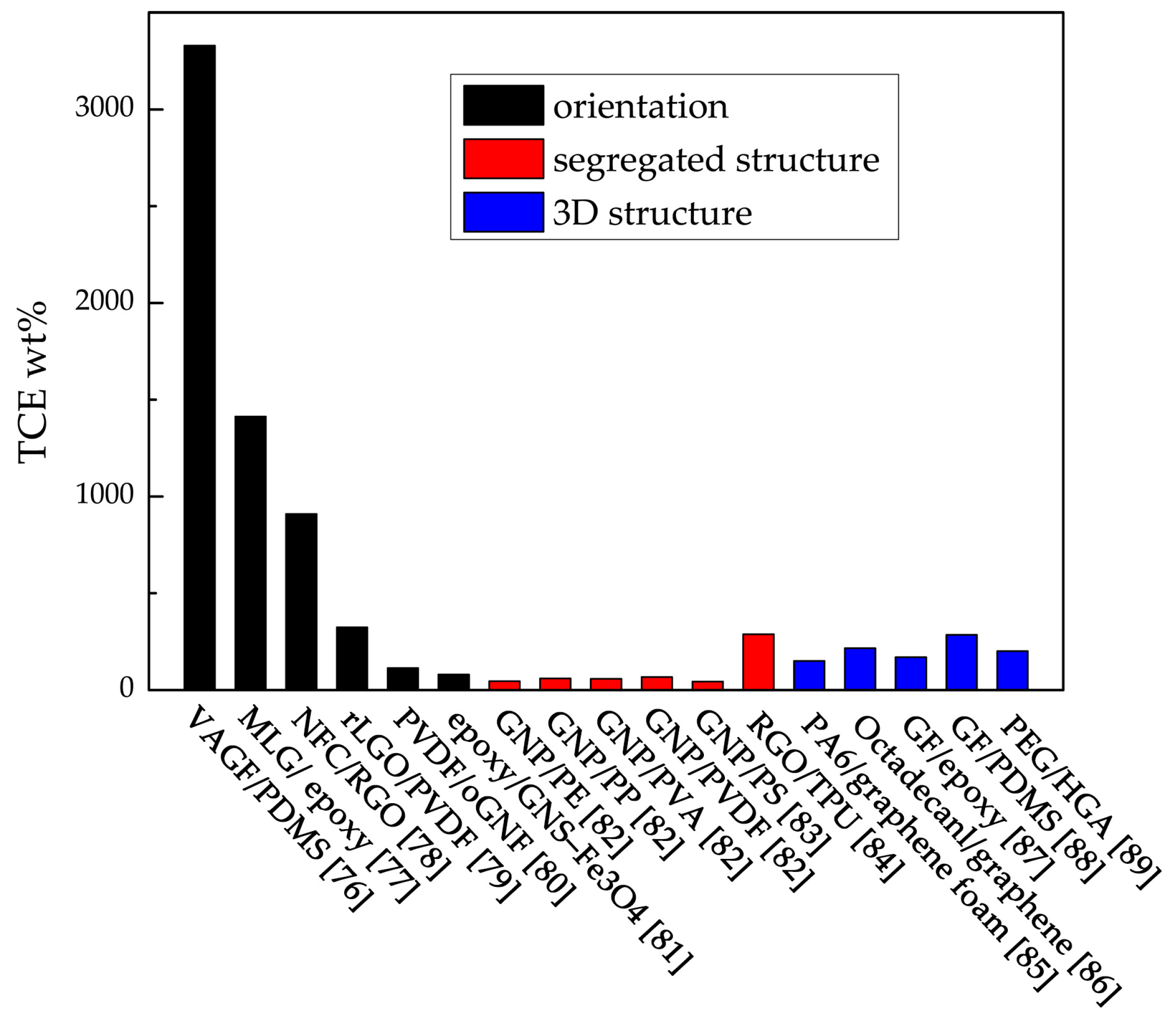
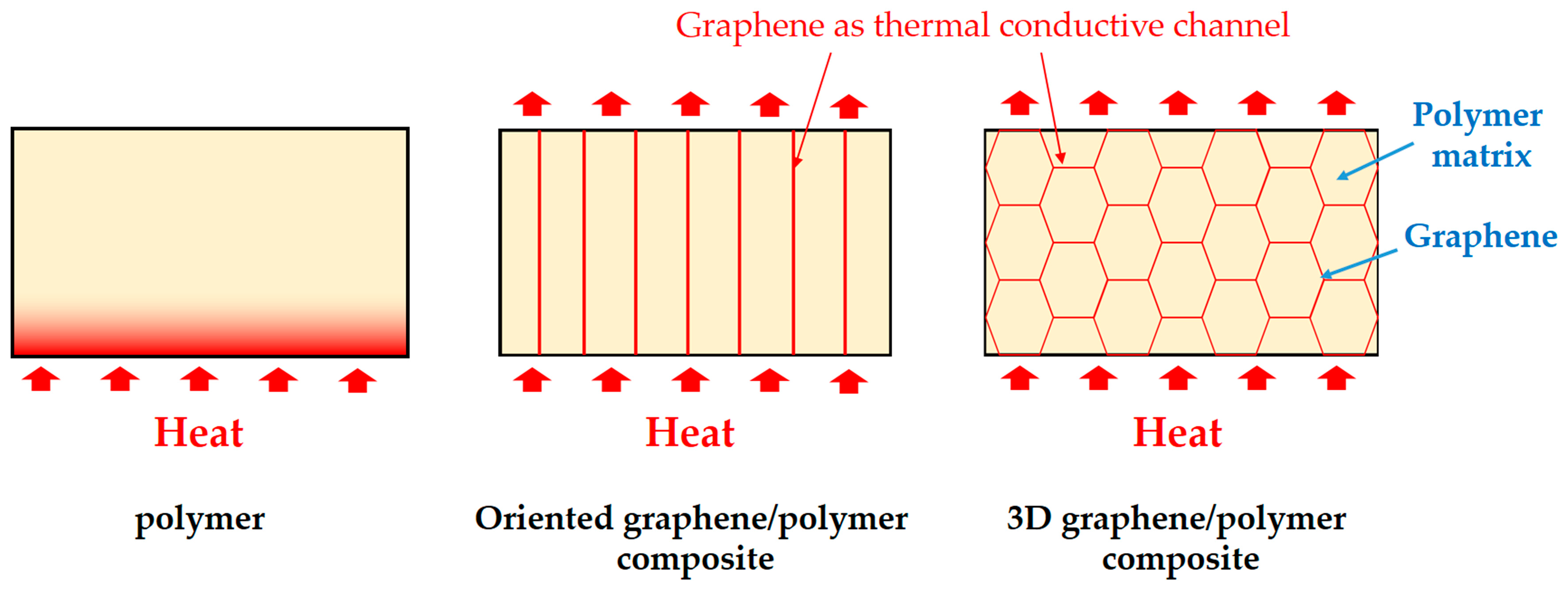

| Sample | Graphene content (wt %) | Thermal conductivity (W m−1 k−1) | Thermal conductivity enhancement (TCE) per wt % | Preparation method | Surface preparation methods |
|---|---|---|---|---|---|
| Py-PGMA-GNS/epoxy [55] | 3.8 | 1.91 | 225% | In-situ polymerization | Non-covalent modification |
| f-GFs/epoxy [56] | 10 | 1.53 | 66.5% | In-situ polymerization | Non-covalent modification |
| GnP-C750/epoxy [57] | 5 | 0.45 | 23.8% | In-situ polymerization | no |
| DGEBA-f-GO/epoxy [58] | 4.64 1 | 0.72 | 52.3% | In-situ polymerization | no |
| GS@Al2O3/PVDF [59] | 40 | 0.586 | 4.8% | solution mixing | Coated by alumina nanoparticals |
| Al2O3@ GNP/epoxy [60] | 12 | 1.49 | 56.4% | solution mixing | Coated by alumina |
| GNP/PBT [61] | 20 | 1.98 | 61% | In-situ polymerization | no |
| GNPs/PPS [62] | 37.8 1 | 4.414 | 49% | melt mixing | Covalent modification |
| PI/SiCNWs-GSs [63] | 7 | 0.577 | 21% | solution mixing | no |
| GP/SR [54] | 0.72 | 0.3 | 69.4% | mechanical blending | Covalent modification |
| PA6/graphene-GO [64] | 10 | 2.14 | 56.9% | In-situ polymerization | Non-covalent modification |
| GNP/epoxy [65] | 25 | 2.67 | 49.4% | solution mixing | no |
| PVDF/FGS/ND [20] | 45 | 0.66 | 3.9% | solution mixing | no |
| ApPOSS-graphene/epoxy [66] | 0.5 | 0.348 | 115.8% | solution mixing | Covalent modification |
| IL-G/PU [67] | 0.608 | 0.3012 | 55.9% | In-situ polymerization | Non-covalent modification |
| PA/TCA-rGO [68] | 5 | 5.1 | 357.8% | melt mixing | Covalent modification |
| BE/graphene [69] | 2.5 | 0.542 | 73.7% | solution mixing | Covalent modification |
| GNPs/silicone [70] | 16 | ~2.6 | 49.7% | In-situ polymerization | no |
| Sample | Graphene content (wt %) | Thermal conductivity (W m−1 k−1) | Thermal conductivity enhancement (TCE) per wt % | Specific orientation of graphene |
|---|---|---|---|---|
| VAGF/PDMS [76] | 92.3 | 614.85 | 3329% | orientation |
| MLG/epoxy [77] | 11.8 | 33.54 | 1412.7% | orientation |
| NFC/RGO [81] | 1 | 12.6 | 910% | orientation |
| rLGO/PVDF [82] | 27.2 | 19.5 | ~323.5% | orientation |
| PVDF/oGNF [83] | ~36.8 | ~10 | ~113.2% | orientation |
| epoxy/GNS–Fe3O4 [84] | ~1.74 | ~0.6 | ~79.9% | orientation |
| GNP/PE [85] | 10 | 1.84 | 45.7% | segregated structure |
| GNP/PP [85] | 10 | 1.53 | 59.5% | segregated structure |
| GNP/PVA [85] | 10 | 1.43 | 58% | segregated structure |
| GNP/PVDF [85] | 10 | 1.47 | 67.3% | segregated structure |
| GNP/PS [86] | ~9.2 | ~0.9 | 43.3% | segregated structure |
| RGO/TPU [87] | 1.04 | 0.8 | 288% | segregated structure |
| PA6/graphene foam [78] | 2 | 0.847 | 150% | 3D structure |
| Octadecanl/graphene [88] | 12 | 5.92 | 216% | 3D structure |
| GF/epoxy [89] | 5 | 1.52 | 170% | 3D structure |
| GF/PDMS [90] | 0.7 | 0.56 | 285% | 3D structure |
| PEG/HGA [79] | 1.8 | 1.43 | 200.6% | 3D structure |
© 2017 by the authors. Licensee MDPI, Basel, Switzerland. This article is an open access article distributed under the terms and conditions of the Creative Commons Attribution (CC BY) license (http://creativecommons.org/licenses/by/4.0/).
Share and Cite
Li, A.; Zhang, C.; Zhang, Y.-F. Thermal Conductivity of Graphene-Polymer Composites: Mechanisms, Properties, and Applications. Polymers 2017, 9, 437. https://doi.org/10.3390/polym9090437
Li A, Zhang C, Zhang Y-F. Thermal Conductivity of Graphene-Polymer Composites: Mechanisms, Properties, and Applications. Polymers. 2017; 9(9):437. https://doi.org/10.3390/polym9090437
Chicago/Turabian StyleLi, An, Cong Zhang, and Yang-Fei Zhang. 2017. "Thermal Conductivity of Graphene-Polymer Composites: Mechanisms, Properties, and Applications" Polymers 9, no. 9: 437. https://doi.org/10.3390/polym9090437







